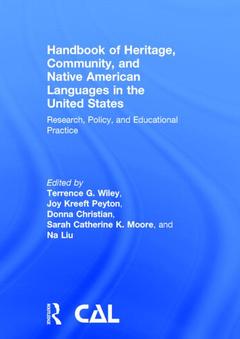Handbook of Heritage, Community, and Native American Languages in the United States Research, Policy, and Educational Practice
Coordonnateurs : Wiley Terrence G., Kreeft Peyton Joy, Christian Donna, Moore Sarah Catherine K., Liu Na

Co-published by the Center for Applied Linguistics
Timely and comprehensive, this state-of-the-art overview of major issues related to heritage, community, and Native American languages in the United States, based on the work of noted authorities, draws from a variety of perspectives?the speakers; use of the languages in the home, community, and wider society; patterns of acquisition, retention, loss, and revitalization of the languages; and specific education efforts devoted to developing stronger connections with and proficiency in them. Contributions on language use, programs and instruction, and policy focus on issues that are applicable to many heritage language contexts. Offering a foundational perspective for serious students of heritage, community, and Native American languages as they are learned in the classroom, transmitted across generations in families, and used in communities, the volume provides background on the history and current status of many languages in the linguistic mosaic of U.S. society and stresses the importance of drawing on these languages as societal, community, and individual resources, while also noting their strategic importance within the context of globalization.
CONTENTS
Preface
Acknowledgments
Section I: Foundations of Heritage, Community, and Native American Language Education
Introduction
Terrence G. Wiley, Joy Kreeft Peyton, Donna Christian, Sarah Catherine K. Moore, and Na Liu
1. Demographic Realities, Challenges, and Opportunities
Molly Fee, Nancy C. Rhodes, and Terrence G. Wiley
2. The Problem of Defining Heritage and Community Languages and Their Speakers: On the Utility and Limitations of Definitional Constructs
Terrence G. Wiley
3. Heritage Language Students: Profiles and Possibilities
Guadalupe Valdés
4. Three Hundred-Plus Years of Heritage Language Education in the United States
Joshua A. Fishman
5. Policy Considerations for Promoting Heritage, Community, and Native American Languages
Terrence G. Wiley
6. Documenting Language Loss and Endangerment: Research Tools and Approaches
Joseph Lo Bianco
7. Professional Opportunities for Heritage Language Speakers
María Carreira
8. Research on Heritage Language Issues
Nelleke Van Deusen-Scholl
Section II: Commonly Taught Languages
Introduction
Ofelia García
9. Spanish in the United States
Kim Potowski
10. French Heritage Language Communities in the United States
Jane F. Ross and Fabrice Jaumont
11. German as a Heritage Language in the United States
Renate Ludanyi
12. Italian and Italians in the United States
Anna De Fina
13. Portuguese Heritage Bilingualism in the United States
Jason Rothman and Tiffany Judy
Section III: Critical and Less Commonly Taught Languages
Introduction
Scott McGinnis
14. Arabic in the United States
Jeff Bale
15. Being “Critical:” Implications for Chinese Heritage Language Schools
Shuhan C. Wang
16. The Journey of Hindi in the United States
Surendra and Vijay Gambhir
17.Russian Heritage Language Learners: From Students’ Profiles to Project-Based Curriculum
Olga Kagan
Section IV: Native American Languages
Introduction
Teresa L. McCarty
18. Navajo
Larisa Warhol and Jeston Morris
19. Pueblo Languages of the Southwest
Christine Sims
20. Oowaaha Myaamiaataweenki: Miami is Spoken Here
Daryl Baldwin
21. Hawaiian: A Native American Language Official for a State
William H. Wilson
22. Warm Springs Languages
Valerie Switzler and Erin Flynn Haynes
Section V: Languages with Strong Community Connections
Introduction
Sarah J. Shin
23. Japanese in the United States
Kimi Kondo-Brown
24. Community Support for Korean as a Heritage Language in the United States
Jin Sook Lee
25. Yiddish: A Jewish Language in the Diaspora
Netta Avineri
26. American Sign Language as a Heritage Language
Sarah E. Compton
27. Khmer
Wayne E. Wright
28. Filipino in the United States: Heritage Language Perspectives
Joseph Axel
Section VI: Promotion of Heritage, Community, and Native American Languages
Introduction
Wayne E. Wright
29. Digital Stories in Heritage Language Education: Empowering Heritage Language Learners Through a Pedagogy of Multiliteracies
Polina Vinogradova
30. Heritage Language Development and Identity Construction Throughout the Life Cycle
Agnes Weiyun He
31. Stakeholder Views of Community-based Heritage Language Programs: Chinese and Korean Cases
Na Liu and Byeong-Keun You
32. Program Models for Heritage Language Education
Sarah Catherine K. Moore
33. Assessment of Heritage Language Learners: Issues and Directions
Margaret E. Malone, Joy Kreeft Peyton, and Katie Kim
34. Preparing Teachers to Work With Heritage Language Learners
Ana María Schwartz Caballero
35. Funding for Heritage Language Programs
Sarah Catherine K. Moore
AfterwordHeritage, Community, and Native American Language Education: Looking to the Future
Joy Kreeft Peyton and Donna Christian
Contributors
Index
Terrence G. Wiley is President, Center for Applied Linguistics, USA and Professor Emeritus, Arizona State University, USA.
Joy Kreeft Peyton is Senior Fellow, Center for Applied Linguistics, USA.
Donna Christian is Senior Fellow, Center for Applied Linguistics, USA.
Sarah Catherine K. Moore is Senior Research Associate, Center for Applied Linguistics, USA.
Na Liu is Senior Research Associate, Center for Applied Linguistics, USA.
Date de parution : 01-2014
17.8x25.4 cm
Date de parution : 02-2014
17.8x25.4 cm
Disponible chez l'éditeur (délai d'approvisionnement : 14 jours).
Prix indicatif 160,25 €
Ajouter au panierThèmes de Handbook of Heritage, Community, and Native American... :
Mots-clés :
Heritage Language; Terrence G; Wiley; Heritage Language Learning; Joy Kreeft Peyton; National Foreign Language Center; Donna Christian; Heritage Language Education; Sarah Catherine K; Moore; Heritage Language Speakers; Na Liu; Heritage Language Programs; heritage languages in the U.S; Heritage Speakers; community languages; NHLRC; language acquisition; use; retention; loss; and revitalization; Professional Development; Language Revitalization; Heritage Language Schools; Native American Languages; Heritage Spanish Speaker; Transitional Bilingual Education; Heritage Language Classes; Heritage Language Student; Hl Learning; Heritage Learners; United States; Hl Development; American Sign Language; Chinese Hl; Chinese Heritage Language Schools; Heritage Language Teachers; Heritage Language Journal



